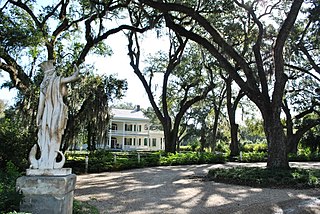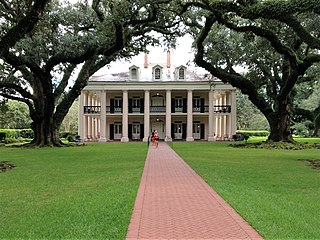Demographics
Historical population| Census | Pop. | Note | %± |
|---|
| 1840 | 2,315 | | — |
|---|
| 1850 | 3,385 | | 46.2% |
|---|
| 1860 | 4,431 | | 30.9% |
|---|
| 1870 | 4,026 | | −9.1% |
|---|
| 1880 | 5,258 | | 30.6% |
|---|
| 1890 | 5,769 | | 9.7% |
|---|
| 1900 | 8,100 | | 40.4% |
|---|
| 1910 | 10,627 | | 31.2% |
|---|
| 1920 | 11,643 | | 9.6% |
|---|
| 1930 | 18,206 | | 56.4% |
|---|
| 1940 | 17,790 | | −2.3% |
|---|
| 1950 | 20,054 | | 12.7% |
|---|
| 1960 | 26,974 | | 34.5% |
|---|
| 1970 | 36,511 | | 35.4% |
|---|
| 1980 | 58,806 | | 61.1% |
|---|
| 1990 | 70,526 | | 19.9% |
|---|
| 2000 | 91,814 | | 30.2% |
|---|
| 2010 | 128,026 | | 39.4% |
|---|
| 2020 | 142,282 | | 11.1% |
|---|
|
At the 2000 United States census, [9] there were 91,814 people, 32,630 households, and 25,549 families residing in the parish. The population density was 142 inhabitants per square mile (55/km2). There were 36,212 housing units at an average density of 56 per square mile (22/km2). The racial makeup of the parish was 94.35% White, 4.22% Black or African American, 0.36% Native American, 0.18% Asian, 0.02% Pacific Islander, 0.19% from other races, and 0.68% from two or more races; 1.11% of the population were Hispanic or Latin American of any race.
There were 32,630 households, out of which 41.60% had children under the age of 18 living with them, 63.10% were married couples living together, 10.70% had a female householder with no husband present, and 21.70% were non-families. 18.20% of all households were made up of individuals, and 6.50% had someone living alone who was 65 years of age or older. The average household size was 2.80 and the average family size was 3.17.
In the parish the population was spread out, with 29.50% under the age of 18, 9.10% from 18 to 24, 31.50% from 25 to 44, 21.40% from 45 to 64, and 8.50% who were 65 years of age or older. The median age was 33 years. For every 100 females, there were 98.50 males. For every 100 females age 18 and over, there were 94.50 males.
The median income for a household in the parish was $38,887, and the median income for a family was $44,071. Males had a median income of $36,508 versus $22,325 for females. The per capita income for the parish was $16,282. As of August 2001, about 43,800 people were employed in the parish. The unemployment rate was 4.8%. About 9.10% of families and 11.40% of the population were below the poverty line, including 11.70% of those under age 18 and 15.80% of those age 65 or over.
Hurricane Katrina had a dramatic effect on the population in Livingston Parish. Many displaced families of the affected parishes have moved into the area, and as a result the population of Livingston Parish has increased significantly. On June 6, 2007, the U.S. Census Bureau published a report "Special Population Estimates for Impacted Counties in the Gulf Coast Area" which showed a population increase for Livingston Parish to 111,863 as of January 1, 2006. [10]
The 2019 American Community Survey estimated 138,928 people and 48,410 households lived in the parish, up from 128,026 at the 2010 United States census. [11] Its racial and ethnic makeup was 90.3% non-Hispanic white, 6.0% Black and African American, 0.4% American Indian and Alaska Native, 0.6% Asian alone, 0.8% some other race, 1.8% two or more races, and 3.7% Hispanic or Latin American of any race. At the 2020 United States census, there were 142,282 people, 47,014 households, and 32,840 families residing in the parish.
Among the population in 2019, 74.1% were aged 18 and older, 6.6% aged 5 and under, and 12.9% aged 65 and older. The median age was 36.6, and 2.2% of the population were foreign born.
An estimated 10,280 businesses were established in the parish, and 1,105 were minority-owned firms. Of the population, 59.3% were employed in the parish and 81.8% owned housing units. The median house value was $167,100, and the median gross rent from 2015 to 2019 was $934. The median household income was $63,389 and 15.2% of the parish lived at or below the poverty line.
Livingston Parish, according to the Association of Religion Data Archives in 2020, is dominated by the Southern Baptist Convention as its single largest religious group. Southern Baptists numbered 30,815 and the Catholic Church was the parish's second largest religious group with 14,007 followed by non-denominational Protestants with 11,230 members. [12]
Politics
For much of its history, Livingston Parish voted Democratic, being characteristic of the "Solid South". It demonstrated Piney Woods voting behavior in 1928, where it was Herbert Hoover’s best parish in Louisiana, though he still lost it by about 3.5%. Like other parishes in the Baton Rouge metropolitan area, Livingston remained loyal to Harry S. Truman in 1948 and to Adlai Stevenson II in 1956, when Louisiana's electoral votes went to Strom Thurmond and Dwight D. Eisenhower respectively. Barry Goldwater became the first Republican to win the parish in 1964. Dixiecrat George Wallace carried the parish in 1968, and Richard Nixon in 1972 made it Republican for the second time. It then returned to the Democrats, going to Jimmy Carter in both 1976 and 1980.
In recent years, Livingston Parish has been one of the most Republican parishes in Louisiana, and one of the most Republican county-equivalents in the nation. It has gone Republican in every presidential election since 1984. In the 2004 election, George W. Bush received 33,976 votes, or 77% of the parish's total, more than three times the 9,895 votes (22%) his opponent, John Kerry, received. [17] The Republicans fared better still in the 2008 election, in which John McCain received 43,269 votes (85% of the total) to just 6,681 votes (13%) for Democrat Barack Obama. Livingston Parish has voted about 85% Republican in every election since then.
United States presidential election results for Livingston Parish, Louisiana [17] | Year | Republican | Democratic | Third party |
|---|
| No. | % | No. | % | No. | % |
|---|
| 2020 | 54,877 | 84.13% | 9,249 | 14.18% | 1,104 | 1.69% |
| 2016 | 48,824 | 84.57% | 6,950 | 12.04% | 1,956 | 3.39% |
| 2012 | 45,513 | 84.19% | 7,451 | 13.78% | 1,098 | 2.03% |
| 2008 | 43,269 | 85.02% | 6,681 | 13.13% | 942 | 1.85% |
| 2004 | 33,976 | 76.78% | 9,895 | 22.36% | 382 | 0.86% |
| 2000 | 24,889 | 67.51% | 11,008 | 29.86% | 968 | 2.63% |
| 1996 | 16,159 | 47.39% | 13,276 | 38.94% | 4,660 | 13.67% |
| 1992 | 14,808 | 47.13% | 11,499 | 36.60% | 5,114 | 16.28% |
| 1988 | 15,779 | 61.29% | 9,659 | 37.52% | 305 | 1.18% |
| 1984 | 17,465 | 65.72% | 8,913 | 33.54% | 198 | 0.75% |
| 1980 | 10,666 | 47.18% | 11,319 | 50.06% | 624 | 2.76% |
| 1976 | 5,555 | 34.95% | 9,875 | 62.13% | 465 | 2.93% |
| 1972 | 7,481 | 72.96% | 1,898 | 18.51% | 874 | 8.52% |
| 1968 | 947 | 7.73% | 1,400 | 11.42% | 9,907 | 80.85% |
| 1964 | 5,508 | 61.08% | 3,509 | 38.92% | 0 | 0.00% |
| 1960 | 954 | 14.39% | 2,881 | 43.47% | 2,793 | 42.14% |
| 1956 | 1,628 | 37.24% | 2,571 | 58.81% | 173 | 3.96% |
| 1952 | 1,436 | 28.64% | 3,578 | 71.36% | 0 | 0.00% |
| 1948 | 264 | 7.61% | 1,841 | 53.04% | 1,366 | 39.35% |
| 1944 | 343 | 12.24% | 2,460 | 87.76% | 0 | 0.00% |
| 1940 | 252 | 7.82% | 2,971 | 92.18% | 0 | 0.00% |
| 1936 | 496 | 17.04% | 2,414 | 82.96% | 0 | 0.00% |
| 1932 | 89 | 4.36% | 1,953 | 95.64% | 0 | 0.00% |
| 1928 | 975 | 48.22% | 1,047 | 51.78% | 0 | 0.00% |
| 1924 | 110 | 14.34% | 657 | 85.66% | 0 | 0.00% |
| 1920 | 218 | 24.41% | 674 | 75.48% | 1 | 0.11% |
| 1916 | 35 | 6.29% | 503 | 90.47% | 18 | 3.24% |
| 1912 | 3 | 0.63% | 379 | 80.13% | 91 | 19.24% |






















